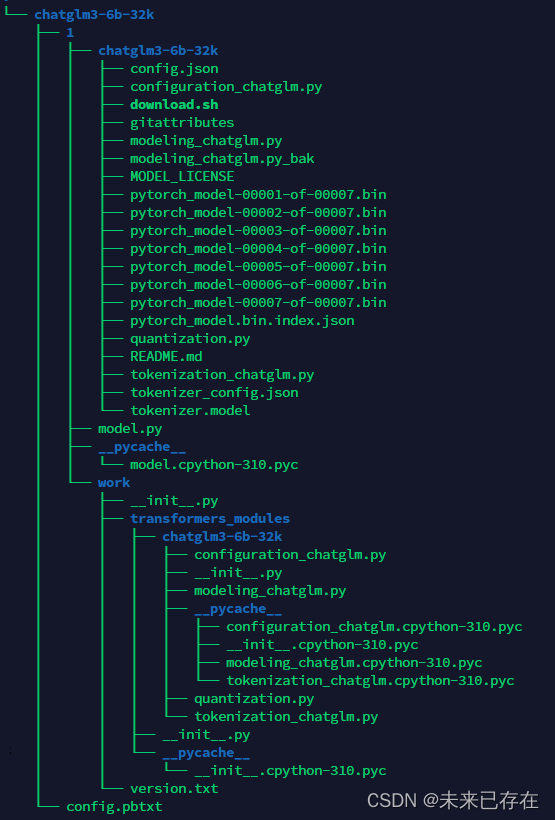triton server使用python backend部署chatglm3-6b-32k_triton部署chatglm3-程序员宅基地
最近在做一个RAG的项目,尝试多种模型以后,发现chatglm3-6b-32k在中文领域明显优于其它模型,基于transformer在测试环境验证后需要生产环境部署,这就需要用到英伟达的triton server。
我们的生产服务器有8块 Tesla T4显卡,如果部署非量化版模型,每一个显卡16G可以部署一个实例(单个实例占用显存12G左右),如果是4bit量化版一个显卡可以部署至少2个实例。
1.拉取triton镜像:
docker pull instill/tritonserver:23.12-py32.创建容器(有两种方式,直接启动triton或者守护模式启动然后进去容器启动triton):
直接启动:
docker run -it --name chatglmtest --gpus all --shm-size=1g --ulimit memlock=-1 -p 8000:8000 -p 8001:8001 -p 8002:8002 --net=host -v /home/server/model_repository:/models --ulimit stack=67108864 nvcr.io/nvidia/tritonserver:23.12-py3 tritonserver --model-repository=/models守护模式:
docker run -itd --name chatglmtest --gpus all --shm-size=1g --ulimit memlock=-1 -p 8000:8000 -p 8001:8001 -p 8002:8002 --net=host -v /home/server/model_repository:/models --ulimit stack=67108864 nvcr.io/nvidia/tritonserver:23.12-py33.进入容器,pip安装模型依赖,torch的cuda版本根据主机的cuda版本确定
docker exec -it chatglmtest bash
#cuda版本跟主机的cuda版本有关
pip install torch torchvision torchaudio --index-url https://download.pytorch.org/whl/cu121
pip install sentence_transformers transformers tiktoken accelerate packaging ninja transformers_stream_generator einops optimum bitsandbytes4.配置模型,模型存放在刚才创建docker容器时映射的目录中/home/server/model_repository
/home/server/model_repository目录结构如下,我只放了一个模型,__pycache__和work目录不用管它,这两个目录是运行triton以后自动生成的。
目录1是模型版本,目录1下面放着huggingface下载下来的模型和model.py(运行脚本)文件。
和目录1平级的需要一个配置文件config.pbtxt,说明输入输出的协议和实例对应GPU的配置

下面开始写配置文件config.pbtxt和model.py。
config.pbtxt
name: "chatglm3-6b-32k" // 模型名,与模型的文件夹名字相同
backend: "python" // 模型所使用的后端引擎
max_batch_size: 0
input [ // 输入定义
{
name: "prompt" //名称
data_type: TYPE_STRING //类型
dims: [ -1 ] //数据维度,-1 表示可变维度
},
{
name: "history"
data_type: TYPE_STRING
dims: [ -1 ]
},
{
name: "temperature"
data_type: TYPE_STRING
dims: [ -1 ]
},
{
name: "max_token"
data_type: TYPE_STRING
dims: [ -1 ]
},
{
name: "history_len"
data_type: TYPE_STRING
dims: [ -1 ]
}
]
output [ //输出定义
{
name: "response"
data_type: TYPE_STRING
dims: [ -1 ]
},
{
name: "history"
data_type: TYPE_STRING
dims: [ -1 ]
}
]
//实例配置,我使用了3个显卡,每个显卡配置了一个实例
instance_group [
{
count: 1
kind: KIND_GPU
gpus: [ 0 ]
},
{
count: 1
kind: KIND_GPU
gpus: [ 1 ]
},
{
count: 1
kind: KIND_GPU
gpus: [ 2 ]
}
]model.py
import os
# 设置显存空闲block最大分割阈值
os.environ['PYTORCH_CUDA_ALLOC_CONF'] = 'max_split_size_mb:32'
# 设置work目录
os.environ['TRANSFORMERS_CACHE'] = os.path.dirname(os.path.abspath(__file__))+"/work/"
os.environ['HF_MODULES_CACHE'] = os.path.dirname(os.path.abspath(__file__))+"/work/"
import json
# triton_python_backend_utils is available in every Triton Python model. You
# need to use this module to create inference requests and responses. It also
# contains some utility functions for extracting information from model_config
# and converting Triton input/output types to numpy types.
import triton_python_backend_utils as pb_utils
import sys
import gc
import time
import logging
import torch
from transformers import AutoTokenizer, AutoModel, AutoModelForCausalLM
import numpy as np
gc.collect()
torch.cuda.empty_cache()
logging.basicConfig(format='%(asctime)s - %(filename)s[line:%(lineno)d] - %(levelname)s: %(message)s',
level=logging.INFO)
class TritonPythonModel:
"""Your Python model must use the same class name. Every Python model
that is created must have "TritonPythonModel" as the class name.
"""
def initialize(self, args):
"""`initialize` is called only once when the model is being loaded.
Implementing `initialize` function is optional. This function allows
the model to intialize any state associated with this model.
Parameters
----------
args : dict
Both keys and values are strings. The dictionary keys and values are:
* model_config: A JSON string containing the model configuration
* model_instance_kind: A string containing model instance kind
* model_instance_device_id: A string containing model instance device ID
* model_repository: Model repository path
* model_version: Model version
* model_name: Model name
"""
# You must parse model_config. JSON string is not parsed here
self.model_config = json.loads(args['model_config'])
output_response_config = pb_utils.get_output_config_by_name(self.model_config, "response")
output_history_config = pb_utils.get_output_config_by_name(self.model_config, "history")
# Convert Triton types to numpy types
self.output_response_dtype = pb_utils.triton_string_to_numpy(output_response_config['data_type'])
self.output_history_dtype = pb_utils.triton_string_to_numpy(output_history_config['data_type'])
ChatGLM_path = os.path.dirname(os.path.abspath(__file__))+"/chatglm3-6b-32k"
self.tokenizer = AutoTokenizer.from_pretrained(ChatGLM_path, trust_remote_code=True)
#下面to('cuda:'+args['model_instance_device_id'])这里一定要注意,这里是把实例部署到对应的显卡上,如果不写会分散到所有显卡上或者集中到一个显卡上,都会造成问题
model = AutoModelForCausalLM.from_pretrained(ChatGLM_path,
torch_dtype=torch.float16, trust_remote_code=True).half().to('cuda:'+args['model_instance_device_id'])
self.model = model.eval()
logging.info("model init success")
def execute(self, requests):
"""`execute` MUST be implemented in every Python model. `execute`
function receives a list of pb_utils.InferenceRequest as the only
argument. This function is called when an inference request is made
for this model. Depending on the batching configuration (e.g. Dynamic
Batching) used, `requests` may contain multiple requests. Every
Python model, must create one pb_utils.InferenceResponse for every
pb_utils.InferenceRequest in `requests`. If there is an error, you can
set the error argument when creating a pb_utils.InferenceResponse
Parameters
----------
requests : list
A list of pb_utils.InferenceRequest
Returns
-------
list
A list of pb_utils.InferenceResponse. The length of this list must
be the same as `requests`
"""
output_response_dtype = self.output_response_dtype
output_history_dtype = self.output_history_dtype
# output_dtype = self.output_dtype
responses = []
# Every Python backend must iterate over everyone of the requests
# and create a pb_utils.InferenceResponse for each of them.
for request in requests:
prompt = pb_utils.get_input_tensor_by_name(request, "prompt").as_numpy()[0]
prompt = prompt.decode('utf-8')
history_origin = pb_utils.get_input_tensor_by_name(request, "history").as_numpy()
if len(history_origin) > 0:
history = np.array([item.decode('utf-8') for item in history_origin]).reshape((-1,2)).tolist()
else:
history = []
temperature = pb_utils.get_input_tensor_by_name(request, "temperature").as_numpy()[0]
temperature = float(temperature.decode('utf-8'))
max_token = pb_utils.get_input_tensor_by_name(request, "max_token").as_numpy()[0]
max_token = int(max_token.decode('utf-8'))
history_len = pb_utils.get_input_tensor_by_name(request, "history_len").as_numpy()[0]
history_len = int(history_len.decode('utf-8'))
# 日志输出传入信息
in_log_info = {
"in_prompt":prompt,
"in_history":history,
"in_temperature":temperature,
"in_max_token":max_token,
"in_history_len":history_len
}
logging.info(in_log_info)
response,history = self.model.chat(self.tokenizer,
prompt,
history=history[-history_len:] if history_len > 0 else [],
max_length=max_token,
temperature=temperature)
# 日志输出处理后的信息
out_log_info = {
"out_response":response,
"out_history":history
}
logging.info(out_log_info)
response = np.array(response)
history = np.array(history)
response_output_tensor = pb_utils.Tensor("response",response.astype(self.output_response_dtype))
history_output_tensor = pb_utils.Tensor("history",history.astype(self.output_history_dtype))
final_inference_response = pb_utils.InferenceResponse(output_tensors=[response_output_tensor,history_output_tensor])
responses.append(final_inference_response)
# Create InferenceResponse. You can set an error here in case
# there was a problem with handling this inference request.
# Below is an example of how you can set errors in inference
# response:
#
# pb_utils.InferenceResponse(
# output_tensors=..., TritonError("An error occured"))
# You should return a list of pb_utils.InferenceResponse. Length
# of this list must match the length of `requests` list.
return responses
def finalize(self):
"""`finalize` is called only once when the model is being unloaded.
Implementing `finalize` function is OPTIONAL. This function allows
the model to perform any necessary clean ups before exit.
"""
print('Cleaning up...')5:启动triton server
#守护模式(-itd创建的容器),进入容器运行
tritonserver --model-repository=/models
#非守护模式(-it创建的容器),在宿主机运行
docker start chatglmtest6:验证
curl -X POST localhost:8000/v2/models/chatglm3-6b-32k/generate \
-d '{"prompt": "你好,请问你叫什么?", "history":[], "temperature":"0.3","max_token":"100","history_len":"0"}'
响应:
{"history":["{'role': 'user', 'content': '你好,请问你叫什么?'}","{'role': 'assistant', 'metadata': '', 'content': '你好!我是一个名为 ChatGLM3-6B 的人工智能助手,是基于清华大学 KEG 实验室和智谱 AI 公司于 2023 年共同训练的语言模型开发的。我的任务是针对用户的问题和要求提供适当的答复和支持。'}"],"model_name":"chatglm3-6b-32k","model_version":"1","response":"你好!我是一个名为 ChatGLM3-6B 的人工智能助手,是基于清华大学 KEG 实验室和智谱 AI 公司于 2023 年共同训练的语言模型开发的。我的任务是针对用户的问题和要求提供适当的答复和支持。"}智能推荐
oracle 12c 集群安装后的检查_12c查看crs状态-程序员宅基地
文章浏览阅读1.6k次。安装配置gi、安装数据库软件、dbca建库见下:http://blog.csdn.net/kadwf123/article/details/784299611、检查集群节点及状态:[root@rac2 ~]# olsnodes -srac1 Activerac2 Activerac3 Activerac4 Active[root@rac2 ~]_12c查看crs状态
解决jupyter notebook无法找到虚拟环境的问题_jupyter没有pytorch环境-程序员宅基地
文章浏览阅读1.3w次,点赞45次,收藏99次。我个人用的是anaconda3的一个python集成环境,自带jupyter notebook,但在我打开jupyter notebook界面后,却找不到对应的虚拟环境,原来是jupyter notebook只是通用于下载anaconda时自带的环境,其他环境要想使用必须手动下载一些库:1.首先进入到自己创建的虚拟环境(pytorch是虚拟环境的名字)activate pytorch2.在该环境下下载这个库conda install ipykernelconda install nb__jupyter没有pytorch环境
国内安装scoop的保姆教程_scoop-cn-程序员宅基地
文章浏览阅读5.2k次,点赞19次,收藏28次。选择scoop纯属意外,也是无奈,因为电脑用户被锁了管理员权限,所有exe安装程序都无法安装,只可以用绿色软件,最后被我发现scoop,省去了到处下载XXX绿色版的烦恼,当然scoop里需要管理员权限的软件也跟我无缘了(譬如everything)。推荐添加dorado这个bucket镜像,里面很多中文软件,但是部分国外的软件下载地址在github,可能无法下载。以上两个是官方bucket的国内镜像,所有软件建议优先从这里下载。上面可以看到很多bucket以及软件数。如果官网登陆不了可以试一下以下方式。_scoop-cn
Element ui colorpicker在Vue中的使用_vue el-color-picker-程序员宅基地
文章浏览阅读4.5k次,点赞2次,收藏3次。首先要有一个color-picker组件 <el-color-picker v-model="headcolor"></el-color-picker>在data里面data() { return {headcolor: ’ #278add ’ //这里可以选择一个默认的颜色} }然后在你想要改变颜色的地方用v-bind绑定就好了,例如:这里的:sty..._vue el-color-picker
迅为iTOP-4412精英版之烧写内核移植后的镜像_exynos 4412 刷机-程序员宅基地
文章浏览阅读640次。基于芯片日益增长的问题,所以内核开发者们引入了新的方法,就是在内核中只保留函数,而数据则不包含,由用户(应用程序员)自己把数据按照规定的格式编写,并放在约定的地方,为了不占用过多的内存,还要求数据以根精简的方式编写。boot启动时,传参给内核,告诉内核设备树文件和kernel的位置,内核启动时根据地址去找到设备树文件,再利用专用的编译器去反编译dtb文件,将dtb还原成数据结构,以供驱动的函数去调用。firmware是三星的一个固件的设备信息,因为找不到固件,所以内核启动不成功。_exynos 4412 刷机
Linux系统配置jdk_linux配置jdk-程序员宅基地
文章浏览阅读2w次,点赞24次,收藏42次。Linux系统配置jdkLinux学习教程,Linux入门教程(超详细)_linux配置jdk
随便推点
matlab(4):特殊符号的输入_matlab微米怎么输入-程序员宅基地
文章浏览阅读3.3k次,点赞5次,收藏19次。xlabel('\delta');ylabel('AUC');具体符号的对照表参照下图:_matlab微米怎么输入
C语言程序设计-文件(打开与关闭、顺序、二进制读写)-程序员宅基地
文章浏览阅读119次。顺序读写指的是按照文件中数据的顺序进行读取或写入。对于文本文件,可以使用fgets、fputs、fscanf、fprintf等函数进行顺序读写。在C语言中,对文件的操作通常涉及文件的打开、读写以及关闭。文件的打开使用fopen函数,而关闭则使用fclose函数。在C语言中,可以使用fread和fwrite函数进行二进制读写。 Biaoge 于2024-03-09 23:51发布 阅读量:7 ️文章类型:【 C语言程序设计 】在C语言中,用于打开文件的函数是____,用于关闭文件的函数是____。
Touchdesigner自学笔记之三_touchdesigner怎么让一个模型跟着鼠标移动-程序员宅基地
文章浏览阅读3.4k次,点赞2次,收藏13次。跟随鼠标移动的粒子以grid(SOP)为partical(SOP)的资源模板,调整后连接【Geo组合+point spirit(MAT)】,在连接【feedback组合】适当调整。影响粒子动态的节点【metaball(SOP)+force(SOP)】添加mouse in(CHOP)鼠标位置到metaball的坐标,实现鼠标影响。..._touchdesigner怎么让一个模型跟着鼠标移动
【附源码】基于java的校园停车场管理系统的设计与实现61m0e9计算机毕设SSM_基于java技术的停车场管理系统实现与设计-程序员宅基地
文章浏览阅读178次。项目运行环境配置:Jdk1.8 + Tomcat7.0 + Mysql + HBuilderX(Webstorm也行)+ Eclispe(IntelliJ IDEA,Eclispe,MyEclispe,Sts都支持)。项目技术:Springboot + mybatis + Maven +mysql5.7或8.0+html+css+js等等组成,B/S模式 + Maven管理等等。环境需要1.运行环境:最好是java jdk 1.8,我们在这个平台上运行的。其他版本理论上也可以。_基于java技术的停车场管理系统实现与设计
Android系统播放器MediaPlayer源码分析_android多媒体播放源码分析 时序图-程序员宅基地
文章浏览阅读3.5k次。前言对于MediaPlayer播放器的源码分析内容相对来说比较多,会从Java-&amp;gt;Jni-&amp;gt;C/C++慢慢分析,后面会慢慢更新。另外,博客只作为自己学习记录的一种方式,对于其他的不过多的评论。MediaPlayerDemopublic class MainActivity extends AppCompatActivity implements SurfaceHolder.Cal..._android多媒体播放源码分析 时序图
java 数据结构与算法 ——快速排序法-程序员宅基地
文章浏览阅读2.4k次,点赞41次,收藏13次。java 数据结构与算法 ——快速排序法_快速排序法